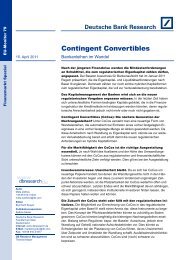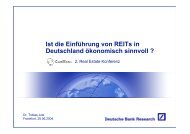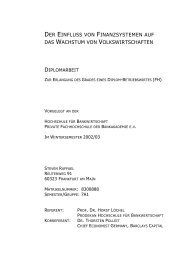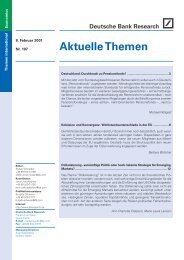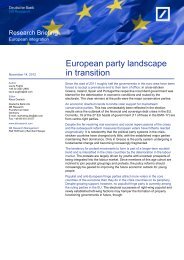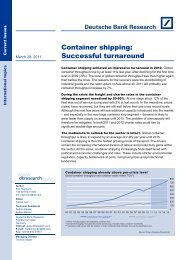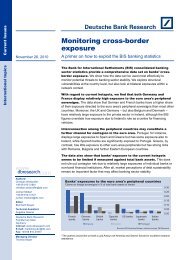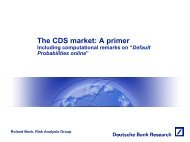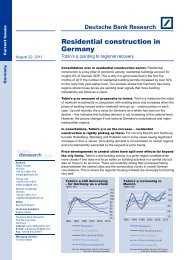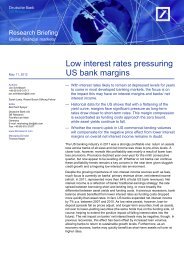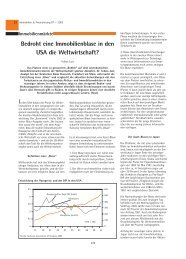Dynamic diversity opens up opportunities - Deutsche Bank Research
Dynamic diversity opens up opportunities - Deutsche Bank Research
Dynamic diversity opens up opportunities - Deutsche Bank Research
Create successful ePaper yourself
Turn your PDF publications into a flip-book with our unique Google optimized e-Paper software.
Density of SMEs and<br />
employment share<br />
CZ<br />
EU-27<br />
FR<br />
UK<br />
Employment effects<br />
HU<br />
PL<br />
DE<br />
0 20 40 60 80 100<br />
SME employment share (%)<br />
90<br />
80<br />
70<br />
60<br />
50<br />
40<br />
30<br />
20<br />
10<br />
Average headcount figures smooth the effects<br />
of company size structure and employment<br />
and are another indicator of the importance of<br />
various enterprise size classes. In the US in<br />
2004 the average SME employed ten workers<br />
in a single facility. The average large firm in<br />
the US, by contrast, employed 3,313 workers<br />
at 62 facilities. Average company size in<br />
Germany is 7.7 employees, whereas in<br />
Mediterranean countries such as Italy or<br />
Greece the average SME headcount is just<br />
two or three persons respectively. The very<br />
small average company size reflects the high<br />
proportion of family-run micro enterprises,<br />
whereas in the US it is the big companies that<br />
have the largest share of the workforce on<br />
their payrolls.<br />
IT<br />
ES<br />
Density of SMEs and<br />
micro enterprises<br />
100<br />
80<br />
60<br />
40<br />
20<br />
0<br />
0<br />
Source: Eurostat 2005<br />
CZ<br />
DE<br />
ES<br />
EU-27<br />
FR<br />
IT<br />
PL<br />
UK<br />
HU<br />
Share of micro enterprises, % (right)<br />
SME density (left)<br />
100<br />
95<br />
90<br />
85<br />
80<br />
75<br />
Density of SMEs (per 1,000 inhabitants)<br />
6<br />
Source: Eurostat 2005 7<br />
Current Issues<br />
all enterprises employ an average of roughly 35-40% of the entire<br />
workforce.<br />
Distinguishing between the size of companies, several differences<br />
can be found between various countries and country gro<strong>up</strong>s:<br />
— Whereas in CEE countries more than 1 in 3 people in work are<br />
employed by micro enterprises (with <strong>up</strong> to 9 employees), in the<br />
US the ratio is only slightly above 1 in 10.<br />
— Compared with other countries Germany has above-average<br />
numbers of people working in small and medium-sized<br />
enterprises and for larger members of the Mittelstand. This<br />
confirms the uniqueness of the German structure, as already<br />
shown with the size classes.<br />
— Although the US and Germany share similarities regarding<br />
company size structure, there are major differences between<br />
their respective employment structures. Nevertheless it is true<br />
that in countries like Germany, France and the US micro<br />
enterprises employ fewer staff than the small and medium-sized<br />
firms. In many other EU-27 countries the opposite is the case.<br />
Given their high contribution to employment it is often assumed that<br />
SMEs provide a bigger boost to the labour market (primarily by<br />
creating jobs) than large companies over the business cycle, cope<br />
better with declines in employment during economic downturns and<br />
dismiss fewer employees than large firms. <strong>Research</strong> conducted in<br />
several countries 6 , however, reveals that at least in micro<br />
enterprises high job growth rates often go hand in hand with high job<br />
loss rates, which calls into question the assertion that SMEs are ―the<br />
engine of job creation‖. Although SMEs create more jobs overall<br />
most of the time, they do this in a very dynamic manner, as shown in<br />
the chart on German companies on page 7. 7 Smaller companies are<br />
responsible for a large proportion of jobs created and jobs lost.<br />
Nearly 40% of companies whose staff numbers have risen or fallen<br />
employ fewer than ten people. The numbers for the US are similar,<br />
where SMEs have created proportionally fewer jobs as they become<br />
larger.<br />
This means that larger companies tend to undergo fewer<br />
fluctuations than smaller companies. Small firms by contrast are<br />
subject to much more volatile employment processes than larger<br />
ones, which means less job security for employees of smaller<br />
companies. Smaller companies have the advantage that they can<br />
act more flexibly and move faster in the labour market besides being<br />
able to adjust more rapidly to structural and cyclical fluctuations.<br />
Conversely, the disadvantage is the uncertainty that these<br />
fluctuations trigger among employees, which means that higherskilled<br />
people find small companies less attractive employers. In<br />
terms of net changes in employment, the largest swings occur at<br />
very small and very large firms. Overall, it is discernible that in the<br />
US and Germany there is an inverse correlation between job<br />
6 Wagner, Koller und Schnabel (2007). Sind mittelständische Betriebe der Jobmotor<br />
der deutschen Wirtschaft? Günterberg und Wallau (2007). Beschäftigungsbeitrag<br />
des Mittelstands 2007 in Deutschland, IfM Bonn. Helfand, Sadeghi und Talan<br />
(2007). Employment dynamics: small and large firms over the business cycle, BLS<br />
USA, Monthly Labor Review. Van Praag (2007). What is the value of<br />
entrepreneurship? A review of recent research, IZA Discussion Paper.<br />
7 IAB Discussion Paper 2/2008. KMU und Arbeitsplatzdynamik − Eine Analyse auf<br />
Basis der Beschäftigten-Historik-Datei. This data is for west Germany as only<br />
separate statistics are available for the western and eastern parts of the country.<br />
The trends in east Germany are, however, comparable.<br />
6 April 15, 2009



